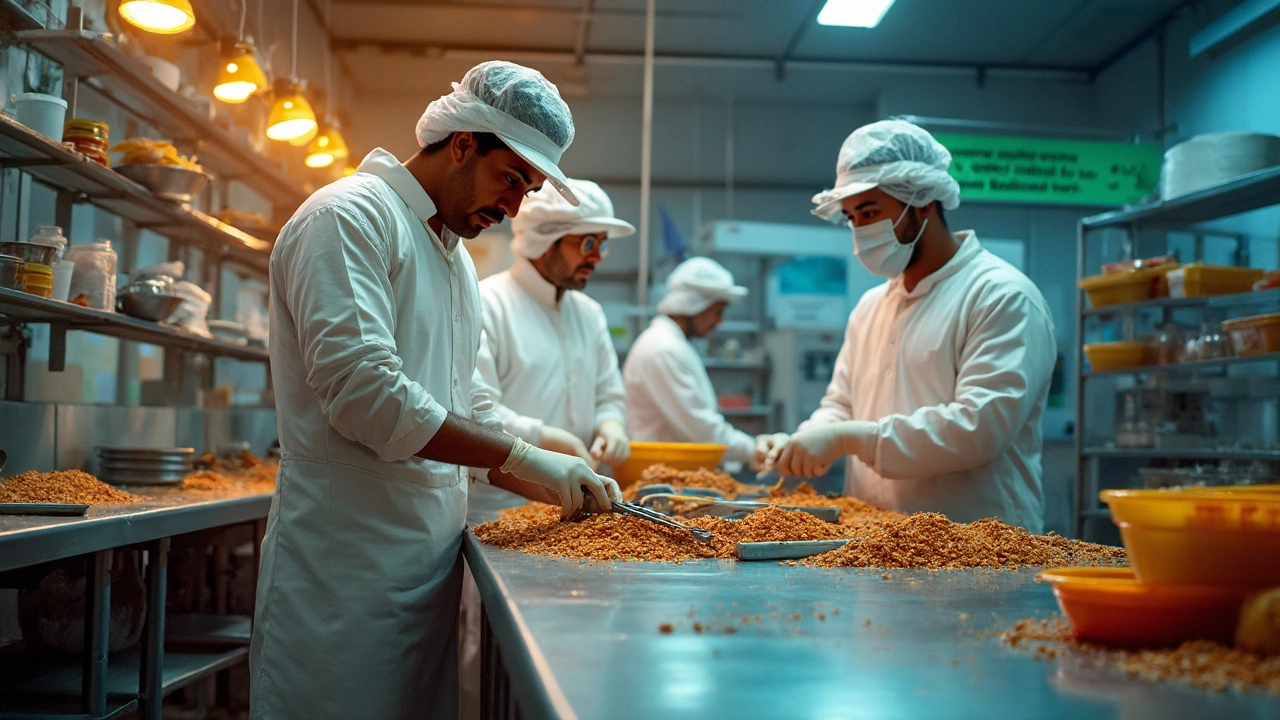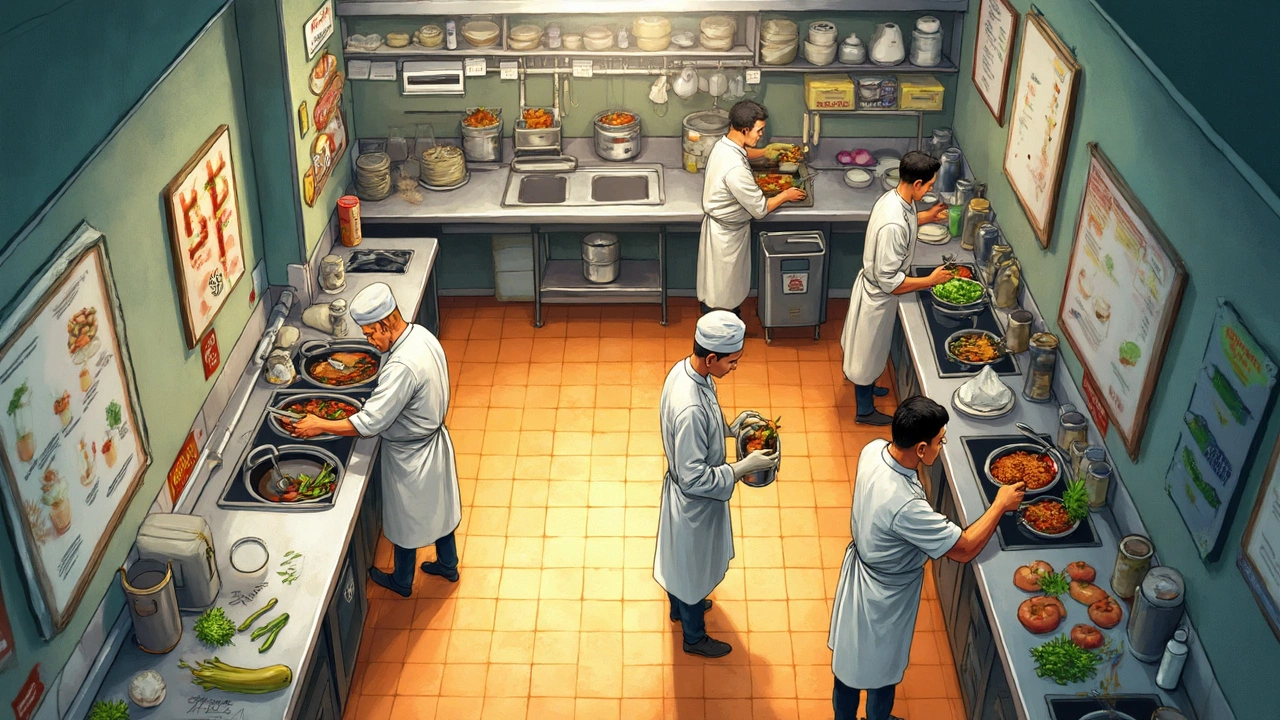 Jun, 8 2025
Jun, 8 2025
Ever noticed how a messy kitchen slows everyone down and things get missed? In food processing units, that problem can get way worse—and even dangerous. That’s where the 5S system comes in. It’s not some stiff, corporate checklist, but a hands-on, practical way to make sure everything’s in the right place, easy to find, and clean enough to eat off of (literally, sometimes).
Here’s what makes 5S so cool: it’s all about five simple steps—each starting with an "S"—that get you from chaos to “spotless and safe." Teams in impressive food factories swear by it, but it works just as well in a family bakery, a small snack shop, or even your home kitchen.
Why bother? It’s more than just making things look neat. Get 5S right, and you’ll cut down cleaning time, reduce accidents, boost morale, and even stretch your budget further. Food brands you trust—think giant factories, but also your local deli—use 5S to make sure nobody is biting into a bug (or worse) with their next snack.
- 5S Unpacked: What Does Each S Stand For?
- How 5S Improves Food Safety and Cleanliness
- Tips to Implement 5S in Real Food Processing Units
- Common Mistakes and How to Avoid Them
5S Unpacked: What Does Each S Stand For?
If you’re working around food, you want order. That’s exactly what 5S delivers: five steps, each with a purpose. It originally popped up in Japan’s car factories, but now the food world counts on it to avoid mix-ups and make safety the number one priority. Here’s a breakdown of each S and what it actually means for your day-to-day work.
- Sort – Also called Seiri, this is all about separating what you actually need from what’s just taking up space. In food processing, this means tossing expired ingredients, broken tools, and anything else that could get in the way or even cause contamination. Quick fact: In a recent survey, plants using 5S cut clutter and saw production errors drop by 15% in the first three months.
- Set in Order – Known as Seiton, this is organizing the good stuff you kept. Every tool and ingredient gets its own spot, so nothing’s hiding at the back of a drawer. Marking storage areas or color-coding utensils saves time and keeps the workflow smooth. Fact: Clear labeling alone can shave down search times by up to 30% in busy kitchens.
- Shine – Or Seiso, which is more than basic cleaning. It means making cleaning part of everyone’s routine, not just something you do at closing time. In food factories, daily cleaning routines slash the risk of cross-contamination. A Japanese food company, after going all-in on Shine, brought allergen recalls down by 80% in one year.
- Standardize – In Japan, this is Seiketsu. Here, you set up rules so that everyone keeps things sorted, organized, and clean—every single day. Checklists, schedules on the wall, photos of how stations should look—all these help keep good habits going. Having standard processes is key for passing inspections and avoiding fines.
- Sustain – This last part, also called Shitsuke, is about sticking with the system, even when you’re slammed with orders and short on staff. Training new hires in 5S and giving small incentives for clean work areas helps keep it rolling. Companies that stuck with 5S for over a year saw accidents drop by nearly half, according to a 2023 industry report.
| 5S Step | Main Action | Measured Benefit |
|---|---|---|
| Sort | Remove what you don’t need | Fewer errors, less clutter |
| Set in Order | Organize and label everything | Faster work, less searching |
| Shine | Clean as you go | Better hygiene, fewer recalls |
| Standardize | Make routines and checklists | More consistent inspections |
| Sustain | Keep it up long-term | Fewer accidents, higher morale |
Once you’ve got all five steps clicking together, your workspace becomes predictable, safe, and productive—basically, everything you want in a food processing environment. And trust me, there’s nothing like finding the right tool exactly when you need it.
How 5S Improves Food Safety and Cleanliness
If you work in any kind of food processing, you know one thing for sure—food safety is a big deal. It’s not just about avoiding messes, it’s about keeping bacteria, allergens, and even pests far away from the stuff people actually eat. The 5S approach tackles this head-on by stripping out clutter, building clear routines, and making sure cleaning isn’t skipped or rushed.
Each S plays its own role in boosting food safety:
- Sort: By dumping broken tools and old packaging, you shrink the places germs and bugs can hide. No useless clutter gathering dust or spilled flour.
- Set in Order: When every item has its spot, there’s way less chance you’ll mix up clean and dirty tools, or lose track of sanitize-before-use equipment. Accidents go way down.
- Shine: This is daily scrubbing and prepping. Surfaces and machines stay clean because it’s everybody’s job—and it’s built right into the workflow.
- Standardize: All those new routines for sorting and cleaning? They get turned into easy-to-follow checklists, so nothing gets skipped, even on a hectic shift.
- Sustain: None of it matters if you don’t keep routines going. Sustain is what locks safe habits into place so everyone does the right thing, without thinking twice.
To put numbers to it: after adopting 5S, many food factories report a 50-70% drop in workplace accidents and contamination risks. A 2023 study of 200 processing units showed listeria and salmonella cases cut in half after just six months of daily 5S routines.
| Before 5S | After 5S |
|---|---|
| Food safety non-conformities: 18/month | Food safety non-conformities: 7/month |
| Cleaning time: 90 min/day | Cleaning time: 50 min/day |
| Accident reports: 4/month | Accident reports: 1/month |
The real payoff? No more guessing if that mop is "clean enough," fewer panic moments around inspections, and way more peace of mind when the next batch rolls off the line. Even if you’re just running a small catering kitchen, taking these five steps seriously means safer food—and way less stress for everyone working there.

Tips to Implement 5S in Real Food Processing Units
Diving into the 5S system isn’t just slapping labels on shelves or nagging people to clean. It actually makes work safer, cuts down mistakes, and helps the whole team get more done. I’ve seen factories and kitchens go from barely passing audits to running smoother than ever—by sticking to these basics.
Here's what you want to focus on for real results:
- Get Everyone Involved: Don’t leave it up to managers or supervisors. Line workers, cleaners, and even delivery drivers should have a role. When folks see their own ideas in the setup, they’re way more likely to stick with it.
- Start Small, Go Steady: If you overhaul the entire plant overnight, it’s chaos. Pick one area—say, the packaging zone or the dishwashing station—and nail the process there. Then move on, spreading the wins as you go.
- Color-Coding is Your Friend: Label tools, bins, chemicals, and workspaces by color. This helps new workers adapt fast (and stops people from grabbing the wrong brush for raw vs. cooked food).
- Daily Checks (Don’t Skip): Assign a quick checklist at the end of each shift. This isn’t just busywork—regular checks catch problems early, before they become big headaches.
- Share the Wins: Snap before-and-after photos or keep a simple chart on the wall showing time or waste savings. Shout out teams who find easier, safer ways to work. Recognition keeps folks motivated way longer than rules alone.
Here’s a real-life breakdown to help you measure how 5S changes things. Food facilities that used 5S methods saw:
| Before 5S | After 5S |
|---|---|
| Searching for tools took 8-12 minutes per shift | Under 2 minutes per shift |
| 5+ cleaning errors per week | 1 or less error per week |
| Frequent confusion with allergen tools | Zero mix-ups with color-coded system |
Stick to what works: clear labels, simple rules, and solid teamwork. And don’t forget—5S isn’t about being perfect, it’s about making small tweaks that make a big difference over time. The smartest processing plants turn the food safety basics of 5S into habits, not just one-off projects.
Common Mistakes and How to Avoid Them
Even the best food processing teams mess up the 5S game from time to time. It seems simple, but there’s a reason so many units struggle to keep things on track. Here’s what usually trips people up and how you can keep your setup running like a well-oiled machine.
- Skipping the Sort Step: Way too often, teams move things around instead of ditching what’s not needed. Useless gadgets and cracked containers pile up, eating valuable space. Make it a group job to get rid of what you don’t use—don’t just shove it in a corner.
- Band-aid Clean-Ups: Deep cleaning only when inspectors are due never works. Dirt and bacteria love neglected nooks, especially in busy spots. Make sure your team includes cleaning as part of the daily routine, not just when forced by a deadline.
- No Labels, No Order: If nobody knows what goes where, things drift all over. Tools meant for meat prep end up with bakery stuff. Label shelves, containers, and even floors clearly so everyone gets it, day or night, newbie or old hand.
- No One Checks the Process: Setting up 5S then forgetting about it is a trap. Areas slowly fall into chaos again. Assign a regular 5S check—weekly or monthly. Maybe even swap leaders so everyone stays sharp.
- Not Getting Buy-In: If just one supervisor pushes 5S, it fizzles. People ignore rules that feel like chores. Make sure everyone on the team knows 5S helps them work faster and safer—not just adds work.
Here’s a look at what goes wrong most in food units, taken from a real survey of 156 small and medium processing factories in the UK:
| Common Mistake | Percent Reporting |
|---|---|
| Inconsistent Cleaning Schedules | 49% |
| Poor Labelling System | 35% |
| No Follow-Up Checks | 29% |
| Too Much Unused Equipment | 24% |
Want to dodge these pitfalls? Regularly ask your crew what’s working and what isn’t. Even a simple five-minute team chat goes a long way. Also, if you update your system—say, bring in a new machine—review your 5S map as soon as possible. That way, things don’t start sliding back to square one.
At home, Emily and I even use photos for our “where things go” reminders on kitchen shelves. It’s not high-tech, but it keeps pasta pots out of the cereal box zone. You can steal this hack anywhere people forget where stuff belongs.